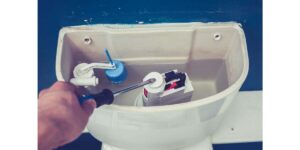It’s easy to overlook the significance of toilet flange in bathroom plumbing, a crucial component often overlooked. But understanding how it works and how a toilet flange connect to the drain pipe can save you a lot of headaches in the long run.
So, let’s explore how a toilet flange connect to the drain pipe and get to know all details about this essential piece of plumbing.
What is a Toilet Flange?
First things first, let’s define what a toilet flange is. A toilet flange is a ring-shaped pipe fitting that connects your toilet to the drain pipe in your bathroom.
It’s typically made of PVC or metal, an essential part of the plumbing system that keeps your toilet securely in place.
The toilet flange is typically located on the floor underneath your toilet. It has a couple of holes used to secure the toilet to the floor using bolts.
The flange also has a slot or opening that allows the wastewater from your toilet to flow into the drain pipe.
Parts of a Toilet Flange
The flange has some parts, like the flange itself, the mounting bolts, and the wax ring.
Let’s take a closer look at each of these elements.
- The Flange: The flange is the main body of the toilet flange and is usually made of either metal or plastic. It’s shaped like a ring with a hole in the center that allows the toilet to sit on top of it.
- The flange also has some holes on the sides that allow the mounting bolts to go through. These bolts secure the toilet to the flange and keep it from moving around.
- The Mounting Bolts: The mounting bolts are two long, thin pieces of metal that go through the holes in the flange and into the toilet. They help to hold the toilet in place and create a watertight seal.
- The Wax Ring: The wax ring is a soft, pliable ring of wax that sits between the flange and the bottom of the toilet. It helps create a watertight seal between the two and prevents leaks.
Types of Toilet Flange
Several toilet flanges are commonly used in residential and commercial plumbing systems. Each of them has its special features and advantages.
Here is a list of some of the most common types:
- PVC Toilet Flange: This type of flange is made of PVC and is commonly used in modern plumbing systems. It is lightweight, durable, and easy to install. PVC toilet flanges are also resistant to corrosion and chemicals.
- Cast Iron Toilet Flange: Cast iron toilet flanges are heavier and more durable than PVC flanges. They are commonly used in older plumbing systems and withstand higher pressure levels.
- Stainless Steel Toilet Flange: Stainless steel toilet flanges are resistant to rust and corrosion. They are often used in commercial plumbing systems where durability is key.
- Brass Toilet Flange: Brass toilet flanges are also durable and corrosion-resistant. They are often used in high-end residential plumbing systems.
How Does a Toilet Flange Connect to the Drain Pipe?
Now that you understand the different parts and types of a toilet flange. Let’s talk about how it connects to the drain pipe.
The toilet flange is usually connect to the drain pipe using a series of bolts and washers.
These bolts go through the flange and into the drain pipe, creating a secure connection.
The flange is usually connected to the drain pipe before the toilet is installed.
This means that the toilet sits on top of the flange, and the flange is already connected to the drain pipe.
However, there are some cases where the flange needs to be installed after the toilet has been put in place.
This might be necessary if the flange has become damaged or the toilet needs replacing.
In these cases, the toilet will need to be removed, and the flange will need to be installed.
Once the flange is in place, the toilet can be reinstalled, and the mounting bolts and wax ring can create a watertight seal.
Problems with Toilet Flanges
Toilet flanges are prone to problems and can cause all sorts of issues if improperly maintained.
Here are a few common problems that you might encounter with your toilet flange:
Leaks
One of the most common problems with toilet flanges is leaks. These leaks can occur if the wax ring is not seated correctly or the mounting bolts are loose.
To fix this problem, you must remove the toilet and check the wax ring and mounting bolts.
If the wax ring is damaged, you’ll need to replace it. If the mounting bolts are loose, you must tighten them up.
Corrosion
Another issue you might encounter with your toilet flange is corrosion.
This can occur if the flange is made of metal and is exposed to water and moisture over time.
To fix this problem, you’ll need to remove the toilet and inspect the flange for signs of corrosion.
If the corrosion is severe, you’ll need to replace the flange.
If it’s just surface-level corrosion, you might be able to clean it up and treat it with a corrosion-resistant spray.
Misalignment
If the flange is not correctly aligned with the drain pipe, it can cause many problems.
This can result in leaks and problems with the toilet, such as rocking or wobbling.
To fix this problem, you’ll need to remove the toilet and check the alignment of the flange.
You’ll need to adjust or replace it if it’s not correctly aligned.
Broken Flange
Sometimes, the flange might become damaged or broken. Various things, such as age, corrosion, or improper installation, can cause this.
You’ll need to remove the toilet and replace the broken flange with a new one to fix this problem.
Tips for Maintaining Your Toilet Flange
Now that you understand the anatomy of a toilet flange and the problems that can occur.
Let’s talk about maintaining it and keeping it in good working order.
Check for Leaks Regularly
One of the most important things you can do to maintain your toilet flange is to check for leaks regularly.
This can be done by flushing the toilet and checking for water around the base.
If you notice a leak, it’s essential to address it immediately to prevent further damage.
Replace the Wax Ring Regularly
The wax ring is an important component of the toilet flange that helps to create a watertight seal.
Over time, the wax ring can become damaged or hardened, leading to leaks.
To prevent this, replacing the wax ring every few years is a good idea.
This is a relatively simple process that can be done in just a few steps:
- Turn off the water supply to the toilet.
- Flush the toilet to empty the tank.
- Disconnect the water supply line from the bottom of the tank.
- Loosen the mounting bolts that hold the toilet to the flange.
- Carefully lift the toilet off the flange.
- Remove the old wax ring and clean the area around the flange.
- Install the new wax ring and place the toilet on top of it.
- Tighten the mounting bolts to secure the toilet in place.
- Reconnect the water supply line and turn the water back on.
Clean and Protect the Flange
To help prevent corrosion and keep your toilet flange in good working order, it’s a good idea to clean it regularly and protect it with a corrosion-resistant spray.
You can use a soft cloth and a mild cleaning to clean the flange.
Be sure to dry the flange thoroughly before applying a corrosion-resistant spray to help protect it from moisture.
Replace the Flange if Necessary
If you notice that your flange is damaged or broken, it’s crucial to replace it as soon as possible.
This will help to prevent leaks and other issues from occurring.
To replace the flange, you’ll need to follow the same steps as when replacing the wax ring.
However, instead of just removing the old wax ring, you’ll need to remove the old flange and install a new one.
To do this, you’ll need to do these steps:
- Turn off the water supply to the toilet.
- Flush the toilet to empty the tank.
- Disconnect the water supply line from the bottom of the tank.
- Loosen the mounting bolts that hold the toilet to the flange.
- Carefully lift the toilet off the flange.
- Remove the old wax ring and flange.
- Clean the area around the flange and inspect the drain pipe for any damage.
- Install the new flange and wax ring, ensuring they’re appropriately seated and aligned with the drain pipe.
- Place the toilet back on top of the flange and tighten the mounting bolts.
- Reconnect the water supply line and turn the water back on.
Conclusion
The toilet flange is a crucial component of your plumbing system that helps connect your toilet to the drain pipe.
Whether you have a plastic, metal, or wax ring flange, keeping it well-maintained and fixing any issues that may arise is essential.
By understanding how it works and how it connects to your drain pipe, you can take better care of your plumbing system and keep your home running smoothly.
Remember, if you suspect a problem with your toilet flange, it’s always best to call a professional plumber for help.
They have the tools and expertise to diagnose and fix any issues you may be experiencing.




